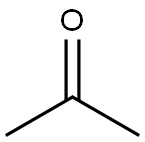Acetone suppliers
Acetone
- CAS:
- 67-64-1
- MF:
- C3H6O
- MW:
- 58.08
Properties
- Melting point:
- -94 °C(lit.)
- Boiling point:
- 56 °C760 mm Hg(lit.)
- Density
- 0.791 g/mL at 25 °C(lit.)
- vapor density
- 2 (vs air)
- vapor pressure
- 184 mm Hg ( 20 °C)
- FEMA
- 3326 | ACETONE
- refractive index
- n
20/D 1.359(lit.)
- Flash point:
- 1 °F
- storage temp.
- Store at +5°C to +30°C.
- solubility
- Miscible with water and with ethanol (96 per cent).
- pka
- 19.3(at 25℃)
- form
- Liquid
- Specific Gravity
- 0.79 (25/25℃)
- color
- Colorless, invisible vapor
- Odor
- Characteristic pungent odor detectable at 33 to 700 ppm (mean = 130 ppm)
- PH
- 5-6 (395g/l, H2O, 20°C)
- Relative polarity
- 0.355
- Odor Threshold
- 42ppm
- explosive limit
- 2.6-12.8%(V)
- Odor Type
- solvent
- Water Solubility
- soluble
- JECFA Number
- 139
- Merck
- 14,66
- BRN
- 63580
- Henry's Law Constant
- 2.27 at 14.9 °C, 3.03 at 25 °C, 7.69 at 35.1 °C, 11.76 at 44.9 °C (Betterton, 1991)
- Exposure limits
- TLV-TWA 1780 mg/m3 (750 ppm), STEL 2375 mg/m3 (ACGIH); 10 h–TWA 590 mg/m3 (250 ppm); IDLH 20,000 ppm (NIOSH).
- Dielectric constant
- 1.0(0℃)
- LogP
- -0.160
Safety Information
- Symbol(GHS)


GHS02,GHS07
- Signal word
- Danger
- Hazard statements
- H225-H319-H336
- Precautionary statements
- P210-P233-P240-P241-P242-P305+P351+P338
- Hazard Codes
- F,Xi,T
- Risk Statements
- 11-36-66-67-39/23/24/25-23/24/25
- Safety Statements
- 9-16-26-45-36/37-7
- RIDADR
- UN 1090 3/PG 2
- WGK Germany
- 3
- RTECS
- AL3150000
- F
- 3-10
- Autoignition Temperature
- 465 °C
- TSCA
- Yes
- HazardClass
- 3
- PackingGroup
- II
- HS Code
- 29141100
- Toxicity
- LD50 in rats: 10.7 ml/kg orally (Smyth)
- IDLA
- 2,500 ppm
Use
Acetone is used in the chemical industry in numerous applications. The primary use of acetone is to produce acetone cyanohydrin, which is then used in the production of methyl methacrylate (MMA). Another use of acetone in the chemical industry is for bisphenol A (BPA). BPA results form the condensation reaction of acetone and phenol in the presence of an appropriate catalyst. BPA is used in polycarbonate plastics, polyurethanes, and epoxy resins. Polycarbonate plastics are tough and durable and are often used as a glass substitute. In addition to its use as a chemical feedstock and intermediate, acetone is used extensively as an organic solvent in lacquers, varnishes, pharmaceuticals, and cosmetics. Nail polish remover is one of the most common products containing acetone. Acetone is used to stabilize acetylene for transport .
According to relevant laws, regulations, policies and the provisions of this website, this website does not display the product information!
The source is "易制毒化学品". If the information is inaccurate, please contact the platform to modify it.
contact information:info@chemicalbook.com 400-158-660


